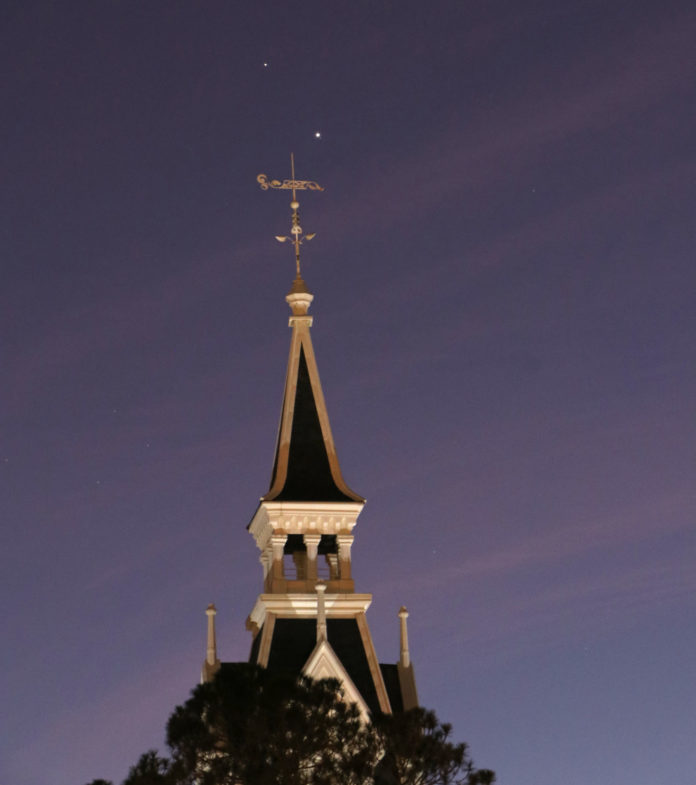
As the holidays draw near, so do the gas giants Jupiter and Saturn. I don’t mean this in the sense that they are getting closer to Earth; that distance is slowly increasing. They are, however, getting closer to each other in the sky from our point of view on Earth.
We are about to experience the Great Conjunction of 2020. A conjunction is not just a grammatical device for hooking up words and phrases. In astronomy, it is a term to indicate the appearance of two objects in approximately the same direction in the sky. Go outside just after sunset tonight, or any clear night up to Dec. 19, and look to the southwest.
You should see two bright “stars” about 20 degrees above the horizon. A good way to approximate that 20-degree angle is to make a fist with your arm fully extended. The angular width of your fist is roughly 10 degrees. The objects you are seeing are not stars but rather the gas giants Jupiter and Saturn. Jupiter is the lower object and looks much brighter than Saturn. You had better check it out quickly because in a few days you will not be able to distinguish the two objects. By Dec. 19, they will be very close together as shown in the diagram below. This diagram is for about 6 p.m.

On Dec. 9, Jupiter and Saturn were very far apart, as the photo of the Mercer University Administration Building at the top of this article shows. As we approach Dec. 20, the angle between them decreases very quickly. On the nights of the 20th and 21st, they will look like one bright object. Then, we will see the angle between them increasing. By Christmas, Saturn will be lower in the sky than Jupiter. Dec. 16 is an interesting date to observe this cosmic dance. On the 16th, the anniversary of the Boston Tea Party, a waxing crescent moon will make a brief appearance in this dance just below Jupiter. By the next night, the moon will have moved much higher in the sky away from the conjunction.
Have you ever thought about what the night sky would look like from another planet? If we on Earth see a conjunction of Jupiter and Saturn, what would it look like from Saturn? The answer to that question can be found in the simulation shown below.

In this image, we are out in space a little beyond Saturn looking back at the Sun. From this point of view, on Dec. 16, we see a conjunction of Jupiter and Earth.
You might wonder if this is some type of rare astronomical event. The answer is yes and no. Jupiter and Saturn have a conjunction about every 20 years. Sometimes it is best observed near sunset and sometimes early in the morning before sunrise. When the conjunction occurs with the pair near the sun in the sky, the glare prevents you from seeing it. We will see a conjunction again on Nov. 2, 2040. Unfortunately, the planets will set before the sun, so you will have to set you alarm for 6 a.m. to see them rise.
What makes this year’s conjunction so special? The answer is the size of the angle between the planets when they seem to converge. On Dec. 21, they will be only about 6 arc minutes or about 1/10 of a degree apart. The full moon is about 30 arc minutes wide or 1/2 degree, so the separation will be about 1/5 of the angular width of the full moon. In the conjunction of 2040, Jupiter and Saturn will be separated by an angle of about two full moons. The next time we will see this very small separation will be March 15, 2080, about the time I retire from Mercer.
There are two stars in the handle of the Big Dipper known as Mizar and Alcor. These two stars are separated by about 12 arc minutes or about twice the minimum angular separation between Jupiter and Saturn this year. There is an old story about Mizar and Alcor being used as an eye test. I often try this with the students in my astronomy class. Some students say that they can distinguish between the two stars, and others see them as just one fuzzy blob.
If we have good weather, go outside and take a look. Perhaps you will be able to distinguish Jupiter and Saturn with your naked eye. Since the Christmas season is upon us, it might be worth mentioning the Christmas star. There is great speculation about this event. One theory is that the star the Wise Men followed on the first Christmas may have actually been some type of conjunction.








